Abstract
OBJECTIVES. Strategies for injury prevention have been extensively studied in developed nations but not in the developing world. This study sought to determine which mechanisms of injury were common in a rural developing area and which were important contributors to mortality and disability. METHODS. All 614 patients admitted for injuries to a rural African hospital between 1987 and 1991 were analyzed retrospectively for mechanism of injury and outcome, as assessed by mortality and long-term functional status. RESULTS. The leading mechanisms of injury were transport related (29%) and burns (16%). Burns accounted for 61% of injuries in children under 5 years. Mortality was 7.3% in the series, with 24% of deaths owing to transport injuries. Disability developed in 103 (22%) of the 462 survivors available for assessment, with most disability resulting from transport injuries (26% of all disabilities), burns (13%), and agricultural injuries (14%). CONCLUSIONS. Among injured patients who presented for treatment in this rural developing area, the largest burden of mortality and disability was from burns and transport-related injuries. Population-based studies are needed to substantiate whether these should be priorities for injury prevention efforts.
Full text
PDF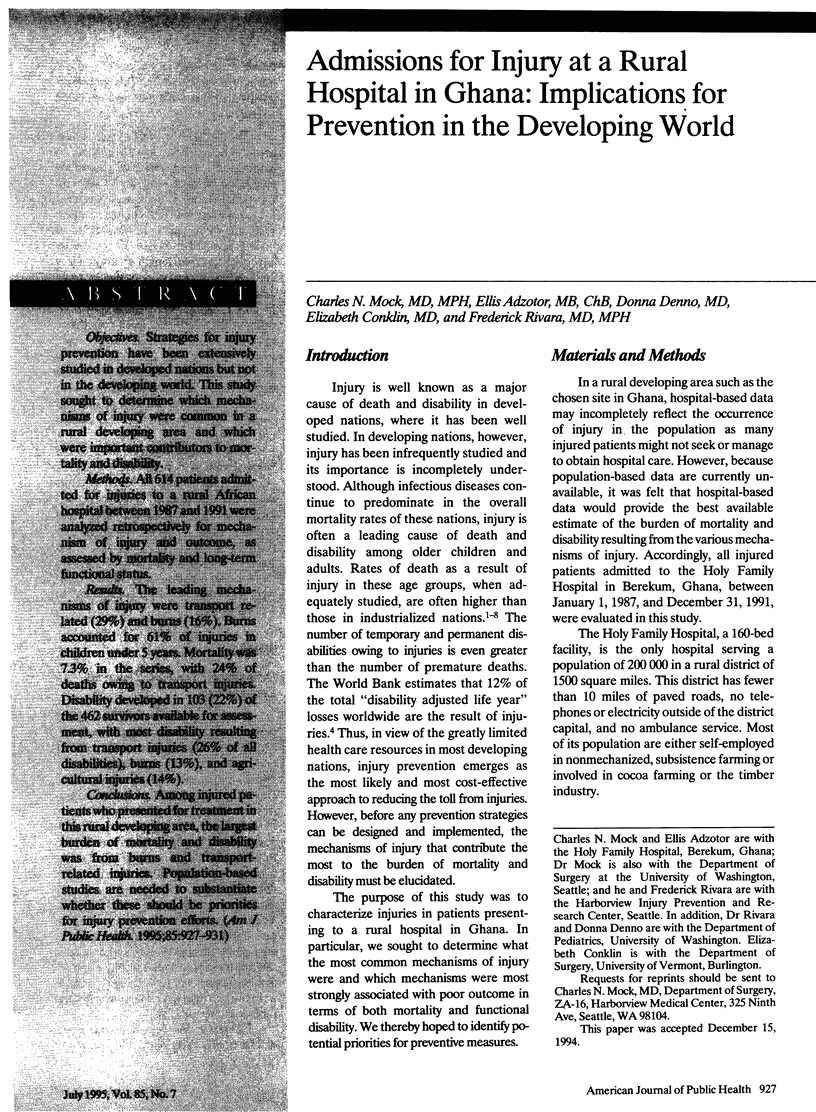
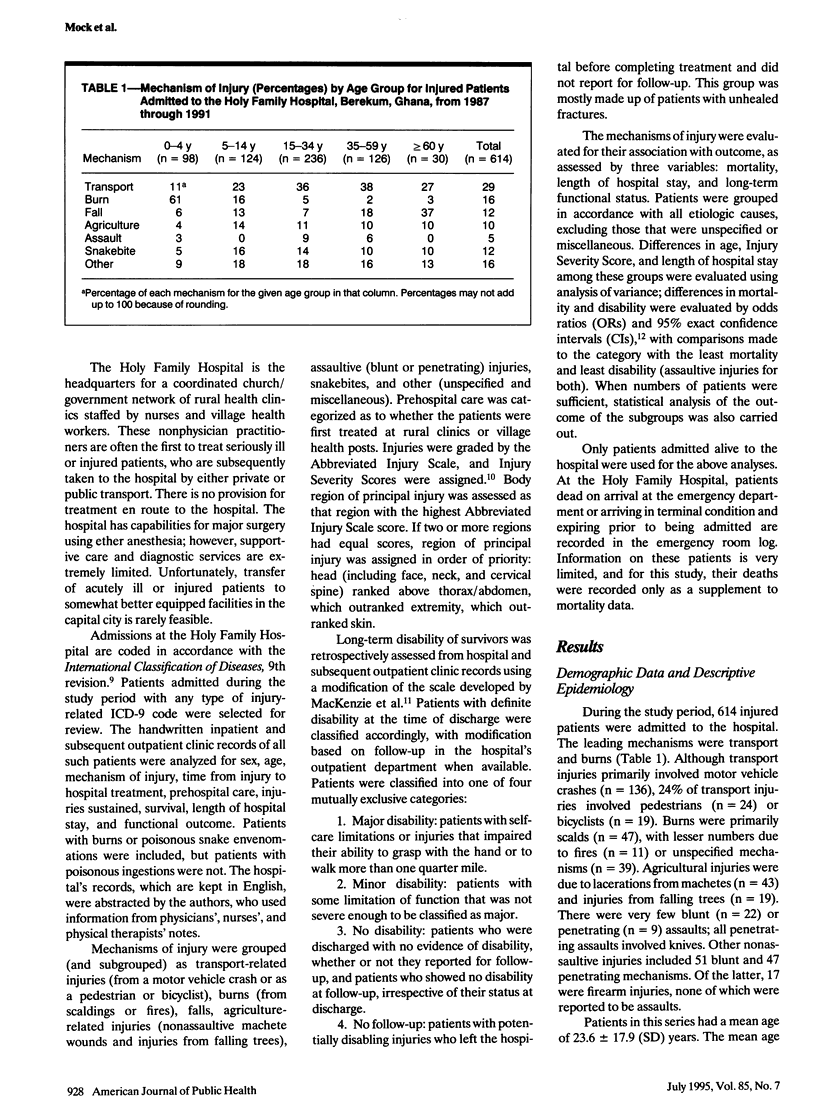
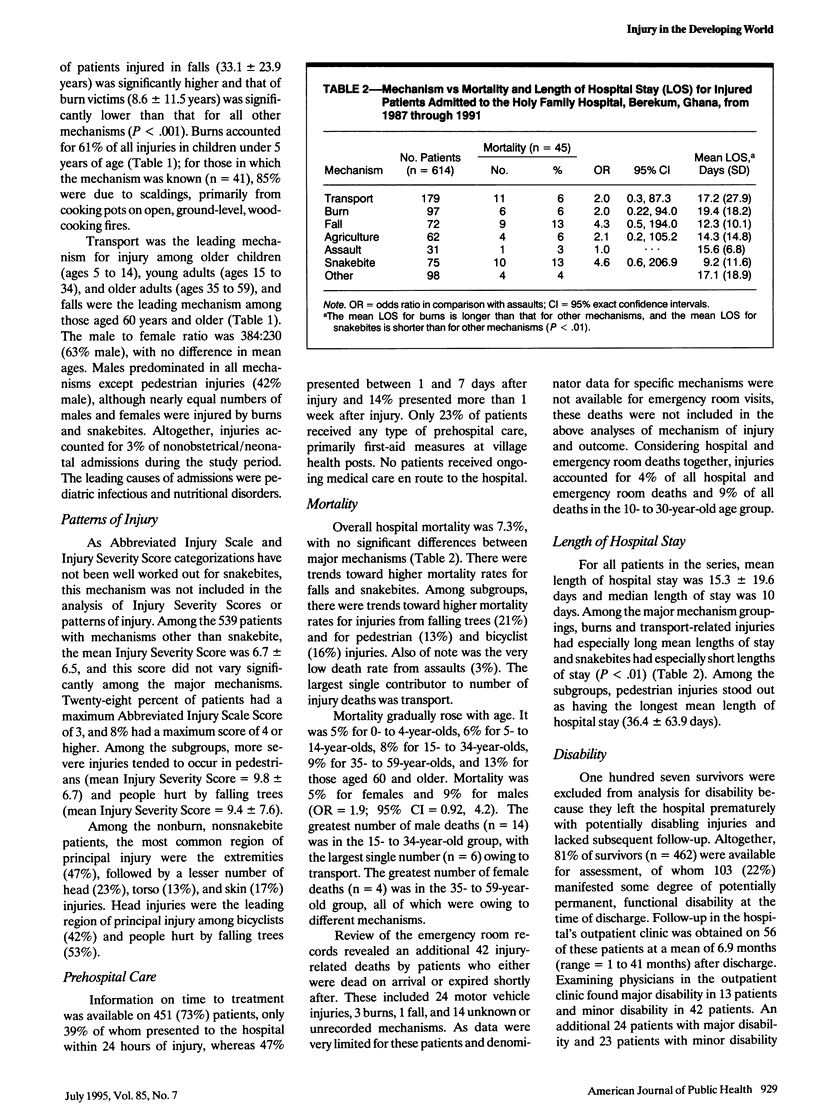
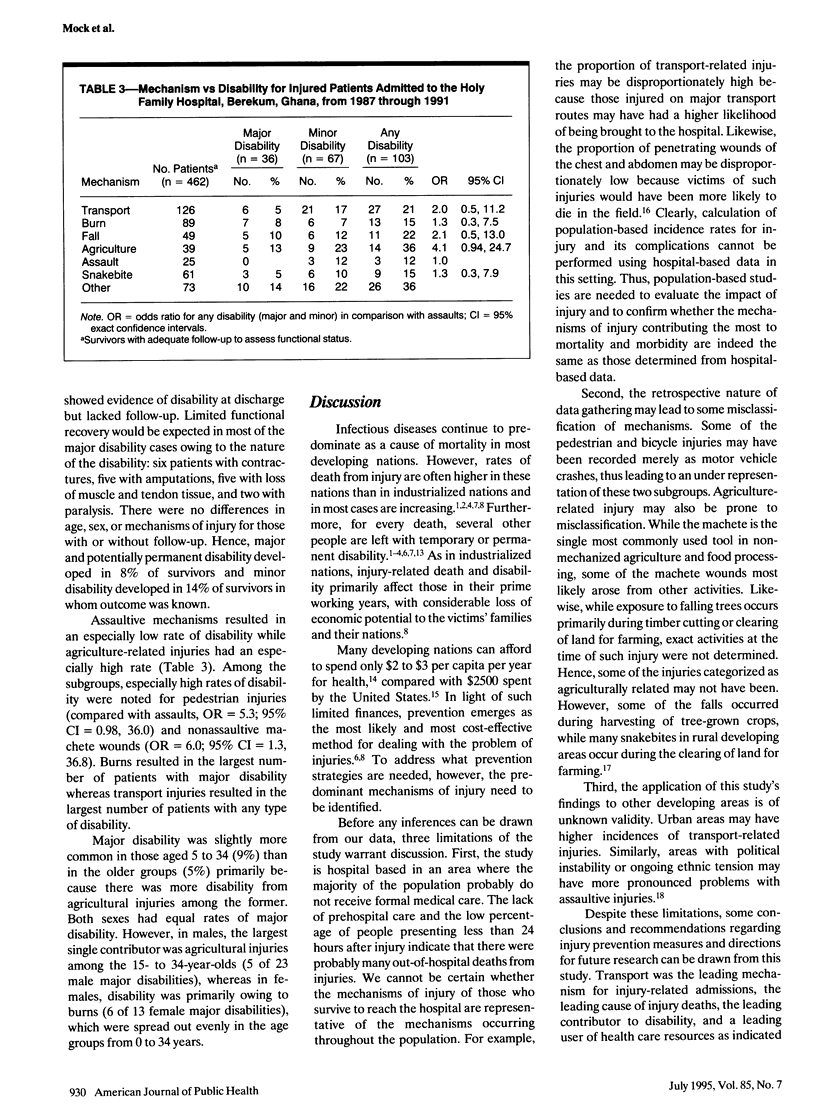
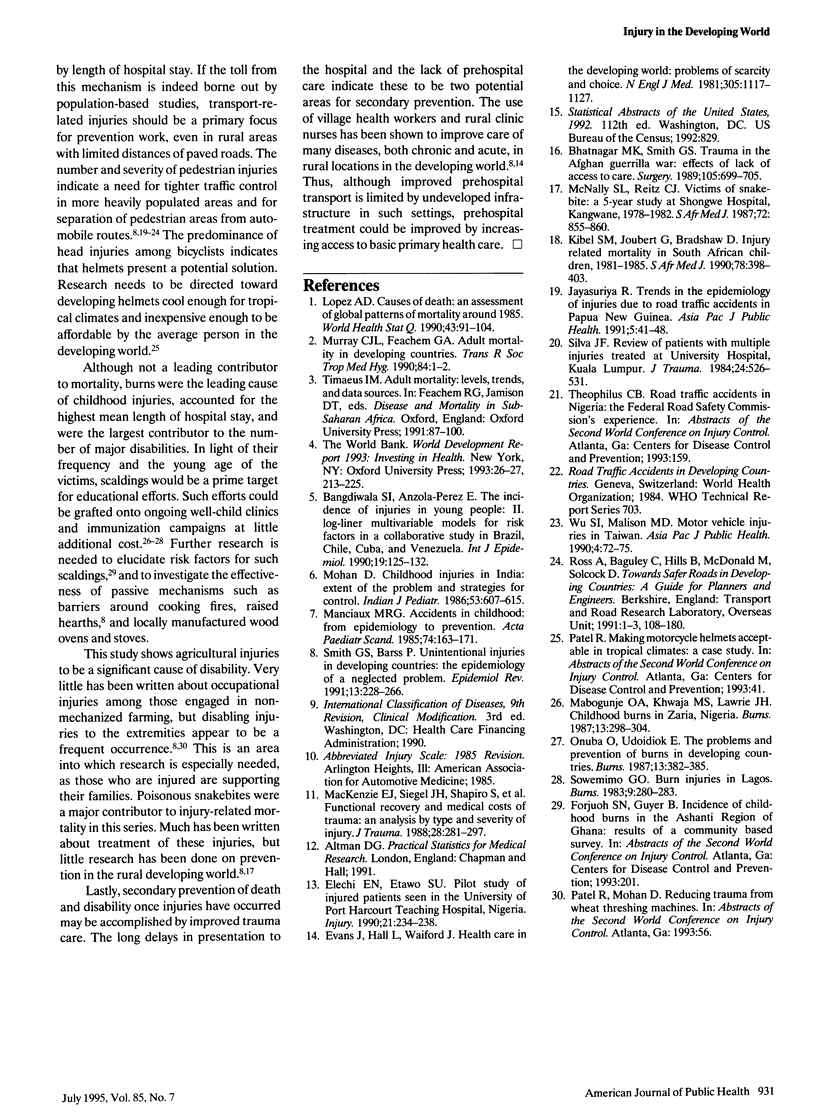
Selected References
These references are in PubMed. This may not be the complete list of references from this article.
- Bangdiwala S. I., Anzola-Pérez E. The incidence of injuries in young people: II. Log-linear multivariable models for risk factors in a collaborative study in Brazil, Chile, Cuba and Venezuela. Int J Epidemiol. 1990 Mar;19(1):125–132. doi: 10.1093/ije/19.1.125. [DOI] [PubMed] [Google Scholar]
- Bhatnagar M. K., Smith G. S. Trauma in the Afghan guerrilla war: effects of lack of access to care. Surgery. 1989 Jun;105(6):699–705. [PubMed] [Google Scholar]
- Elechi E. N., Etawo S. U. Pilot study of injured patients seen in the University of Port Harcourt Teaching Hospital, Nigeria. Injury. 1990 Jul;21(4):234–238. doi: 10.1016/0020-1383(90)90011-i. [DOI] [PubMed] [Google Scholar]
- Evans J. R., Hall K. L., Warford J. Shattuck Lecture--health care in the developing world: problems of scarcity and choice. N Engl J Med. 1981 Nov 5;305(19):1117–1127. doi: 10.1056/NEJM198111053051904. [DOI] [PubMed] [Google Scholar]
- Jayasuriya R. Trends in the epidemiology of injuries due to road traffic accidents in Papua New Guinea. Asia Pac J Public Health. 1991;5(1):41–48. doi: 10.1177/101053959100500110. [DOI] [PubMed] [Google Scholar]
- Kibel S. M., Joubert G., Bradshaw D. Injury-related mortality in South African children, 1981-1985. S Afr Med J. 1990 Oct 6;78(7):398–403. [PubMed] [Google Scholar]
- Lopez A. D. Causes of death: an assessment of global patterns of mortality around 1985. World Health Stat Q. 1990;43(2):91–104. [PubMed] [Google Scholar]
- Mabogunje O. A., Khwaja M. S., Lawrie J. H. Childhood burns in Zaria, Nigeria. Burns Incl Therm Inj. 1987 Aug;13(4):298–304. doi: 10.1016/0305-4179(87)90050-7. [DOI] [PubMed] [Google Scholar]
- MacKenzie E. J., Siegel J. H., Shapiro S., Moody M., Smith R. T. Functional recovery and medical costs of trauma: an analysis by type and severity of injury. J Trauma. 1988 Mar;28(3):281–297. doi: 10.1097/00005373-198803000-00003. [DOI] [PubMed] [Google Scholar]
- Manciaux M. R. Accidents in childhood: from epidemiology to prevention. Acta Paediatr Scand. 1985 Mar;74(2):163–171. doi: 10.1111/j.1651-2227.1985.tb10944.x. [DOI] [PubMed] [Google Scholar]
- McNally S. L., Reitz C. J. Victims of snakebite. A 5-year study at Shongwe Hospital, Kangwane, 1978-1982. S Afr Med J. 1987 Dec 19;72(12):855–860. [PubMed] [Google Scholar]
- Mohan D. Childhood injuries in India: extent of the problem and strategies for control. Indian J Pediatr. 1986 Sep-Oct;53(5):607–615. doi: 10.1007/BF02748664. [DOI] [PubMed] [Google Scholar]
- Murray C. J., Feachem R. G. Adult mortality in developing countries. Trans R Soc Trop Med Hyg. 1990 Jan-Feb;84(1):1–2. doi: 10.1016/0035-9203(90)90364-k. [DOI] [PubMed] [Google Scholar]
- Onuba O., Udoidiok E. The problems and prevention of burns in developing countries. Burns Incl Therm Inj. 1987 Oct;13(5):382–385. doi: 10.1016/0305-4179(87)90128-8. [DOI] [PubMed] [Google Scholar]
- Silva J. F. Review of patients with multiple injuries treated at University Hospital, Kuala Lumpur. J Trauma. 1984 Jun;24(6):526–531. doi: 10.1097/00005373-198406000-00011. [DOI] [PubMed] [Google Scholar]
- Smith G. S., Barss P. Unintentional injuries in developing countries: the epidemiology of a neglected problem. Epidemiol Rev. 1991;13:228–266. doi: 10.1093/oxfordjournals.epirev.a036070. [DOI] [PubMed] [Google Scholar]
- Sowemimo G. O. Burn injuries in Lagos. Burns Incl Therm Inj. 1983 Mar;9(4):280–283. doi: 10.1016/0305-4179(83)90058-x. [DOI] [PubMed] [Google Scholar]
- Wu S. I., Malison M. D. Motor vehicle injuries in Taiwan. Asia Pac J Public Health. 1990;4(1):72–75. doi: 10.1177/101053959000400112. [DOI] [PubMed] [Google Scholar]


